CXCL1
CXCL1(英語:Chemokine (C-X-C motif) ligand 1)是一小分子的細胞因子屬於CXC趨化因子家族[1]。又被稱作生長調節致癌基因α (Growth-regulated oncogene alpha, GROα)[1][2][3]。 趨化因子CXCL1是由巨噬細胞,中性粒細胞和上皮細胞表達的[4][5]。趨化因子CXCL1對中性粒細胞有細胞趨化作用[1]。CXCL1結合到趨化因子受體CXCR2上而起細胞趨化作用[6]。人類的CXCL1與許多CXC類的趨化因子基因相鄰聚集在第四染色體上[7] 。CXCL1的主要作用包括新血管形成、炎症反應、傷口癒合[6]和腫瘤形成[2][3]。
| Chemokine (C-X-C motif) ligand 1 (melanoma growth stimulating activity, alpha) | |||||||||||||
|---|---|---|---|---|---|---|---|---|---|---|---|---|---|
 PDB rendering based on 1mgs. | |||||||||||||
| |||||||||||||
| 標識 | |||||||||||||
| 代號 | CXCL1; FSP; GRO1; GROa; MGSA; MGSA-a; NAP-3; SCYB1 | ||||||||||||
| 擴展標識 | 遺傳學:155730 鼠基因:3037818 同源基因:117693 GeneCards: CXCL1 Gene | ||||||||||||
| 直系同源體 | |||||||||||||
| 物種 | 人類 | 小鼠 | |||||||||||
| Entrez | 2919 | 330122 | |||||||||||
| Ensembl | ENSG00000163739 | ENSMUSG00000029379 | |||||||||||
| UniProt | P09341 | Q6W5C0 | |||||||||||
| mRNA序列 | NM_001511 | NM_203320 | |||||||||||
| 蛋白序列 | NP_001502 | NP_976065 | |||||||||||
| 基因位置 |
Chr 4: 74.74 – 74.74 Mb |
Chr 5: 90.79 – 90.79 Mb | |||||||||||
| PubMed查詢 | [1] | [2] | |||||||||||
參見
編輯參考文獻
編輯- ^ 1.0 1.1 1.2 Moser B, Clark-Lewis I, Zwahlen R, Baggiolini M. Neutrophil-activating properties of the melanoma growth-stimulatory activity. J Exp Med. 1990 May 1;171(5):1797-802.
- ^ 2.0 2.1 Anisowicz, A., Bardwell, L., Sager, R. Constitutive overexpression of a growth-regulated gene in transformed Chinese hamster and human cells. Proc. Nat. Acad. Sci. 84: 7188-7192, 1987.
- ^ 3.0 3.1 Richmond, A., Thomas, H. G. (1988) Melanoma growth stimulatory activity: isolation from human melanoma tumors and characterization of tissue distribution J. Cell. Biochem. 36,185-198
- ^ Iida N, Grotendorst GR. Cloning and sequencing of a new gro transcript from activated human monocytes: expression in leukocytes and wound tissue. Mol Cell Biol. 1990 Oct;10(10):5596-9.
- ^ Becker S, Quay J, Koren HS, Haskill JS. Constitutive and stimulated MCP-1, GRO alpha, beta, and gamma expression in human airway epithelium and bronchoalveolar macrophages. Am J Physiol. 1994 Mar;266(3 Pt 1):L278-86.
- ^ 6.0 6.1 Devalaraja, R. M., Nanney, L. B., Du, J., Qian, Q., Yu, Y., Devalaraja, M. N., Richmond, A. (2000) Delayed wound healing in CXCR2 knockout mice J. Investig. Dermatol. 115,234-244
- ^ Richmond A, Balentien E, Thomas HG, Flaggs G, Barton DE, Spiess J, Bordoni R, Francke U, Derynck R. Molecular characterization and chromosomal mapping of melanoma growth stimulatory activity, a growth factor structurally related to beta-thromboglobulin. EMBO J. 1988 Jul;7(7):2025-33.